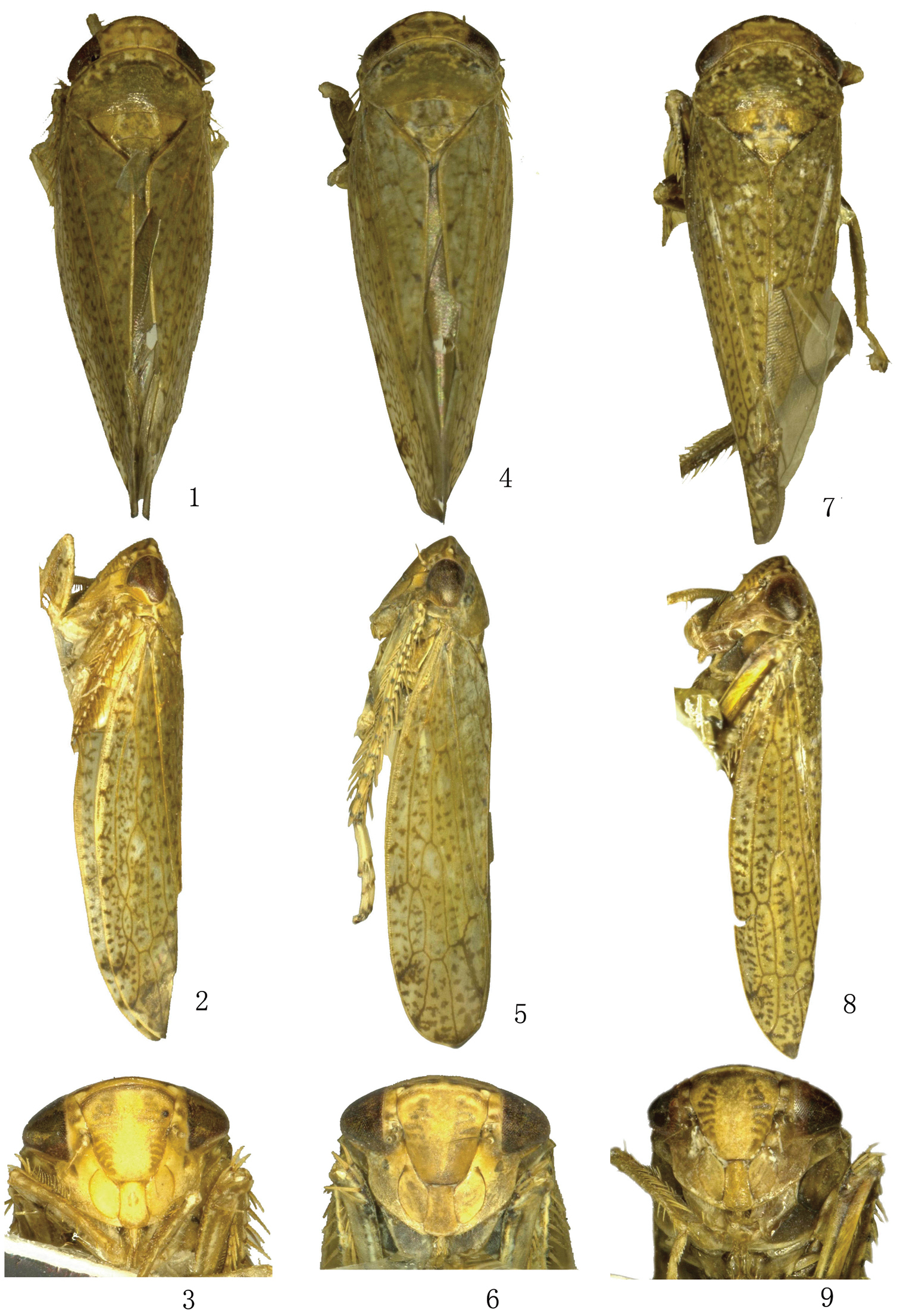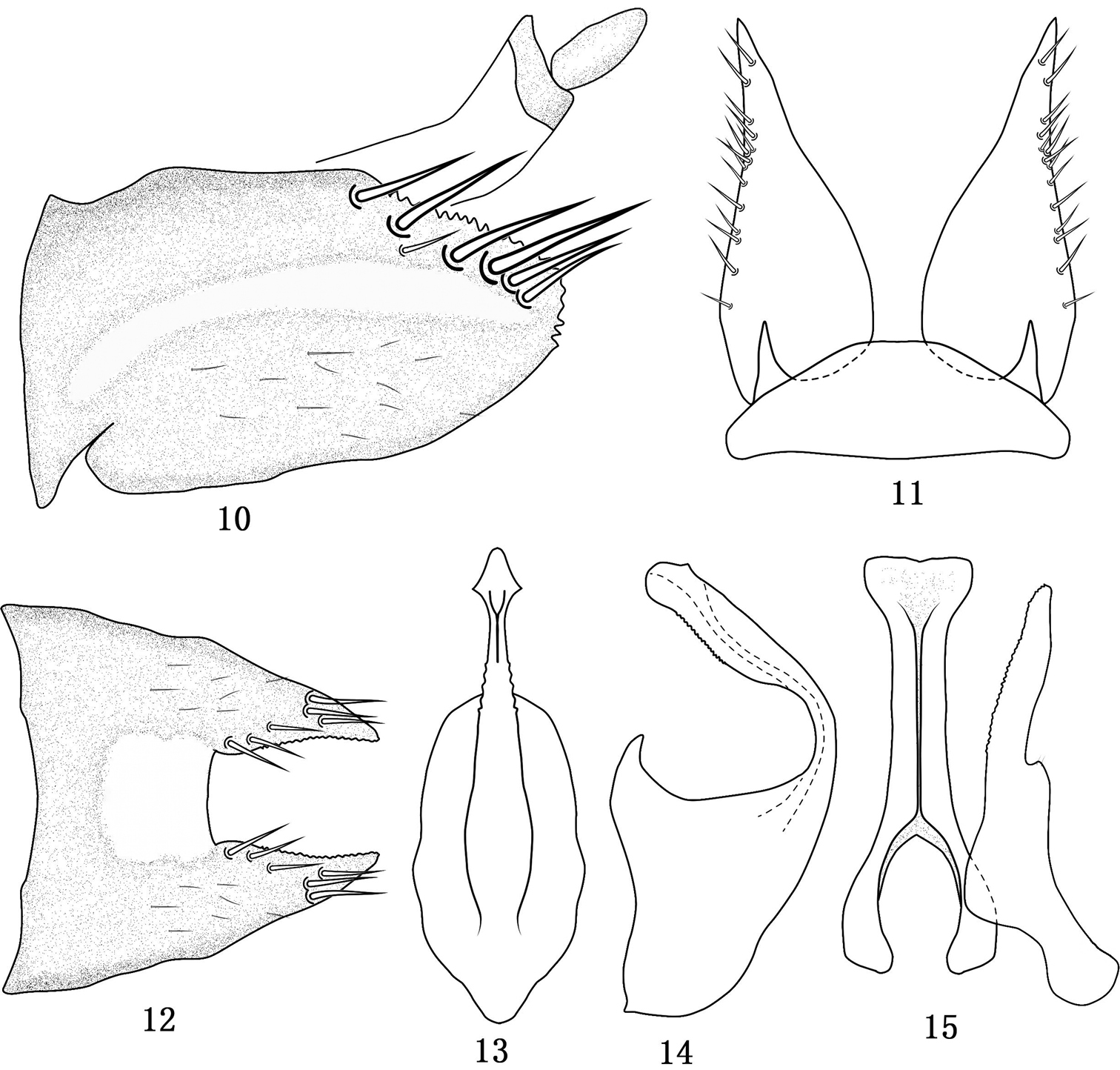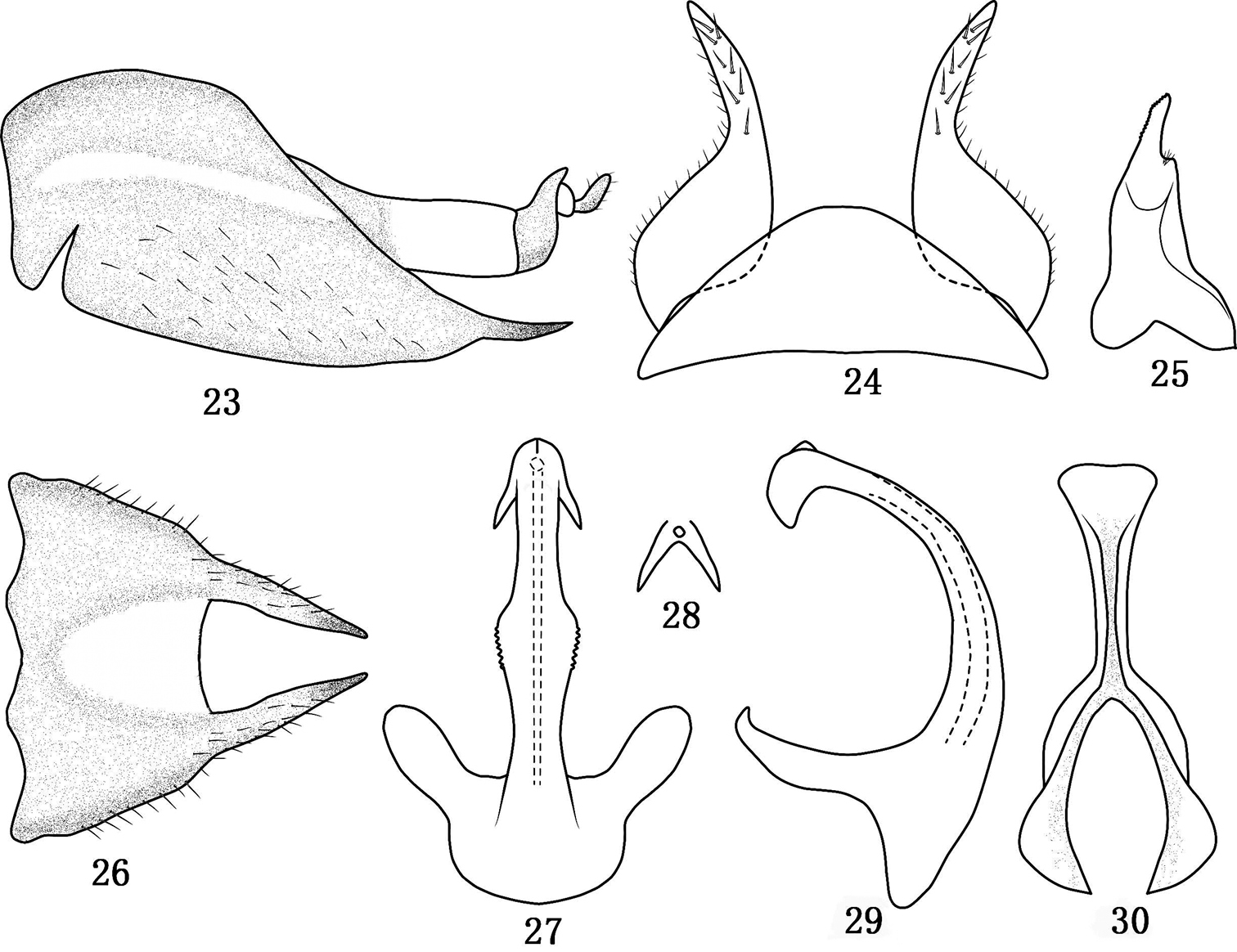






Citation: Qu L, Dai R-H (2014) Three new species of the leafhopper genus Tambocerus Zhang & Webb (Hemiptera, Cicadellidae) from southern China. ZooKeys 434: 47–55. doi: 10.3897/zookeys.434.7712
Three new species, Tambocerus dentatus, T. longicaudatus and T. robustispinus spp. n. from southern China, are described and illustrated. A checklist and distribution to the Tambocerus species from China is provided together with a key for their separation.
Auchenorrhyncha, taxonomy, morphology, China
The Oriental leafhopper genus Tambocerus was established by
In this paper, we describe three new species, Tambocerus dentatus Qu & Dai, sp. n., Tambocerus longicaudatus Qu & Dai, sp. n. and Tambocerus robustispinus Qu & Dai, sp. n. from China, are described and illustrated. A checklist along with distribution records and a key to distinguish species of the genus from China are provided.
Classification system follows that by
Type specimens of the new species are deposited in the Institute of Entomology, Guizhou University, Guiyang, China (GUGC) and one specimen of Tambocerus robustispinus sp. n. is deposited in the British Museum (Natural History), London, U.K. (BMNH).
Selenocephalus disparatus (Melichar, 1903).
This genus can be differentiated from other genera by the following combination of characters: ocelli on margin close to eye, vertex slightly produced medially with anterior margin transversely striate, antennae located at level near to middle of eyes, connective Y-shaped with stem as long or longer than arms and aedeagal shaft laterally serrate.
Palearctic and Oriental region: Sri Lanka, Indian and China.
Tambocerus dentatus Qu & Dai, sp. n.
Distribution. China (Guizhou Province).
Tambocerus elongatus Shen, 2008: 243–246, figs 1–7.
Distribution. China (Hubei, Hunan, Henan, Shaanxi, Guangxi, Hainan, Guangdong, Fujian, Sichuan, Anhui Provinces).
Tambocerus furcellus Shang & Zhang, 2008: 247–248, figs 15–21.
Distribution. China (Hunan Province).
Tambocerus longicaudatus Qu & Dai, sp. n.
Distribution. China (Guizhou Province).
Tambocerus quadricornis Shang & Zhang, 2008: 248, figs 22–28.
Distribution. China (Guangxi Province).
Tambocerus robustispinus Qu & Dai, sp. n.
Distribution. China (Guangxi and Yunnan Provinces).
Tambocerus triangulatus Shen, 2008: 246–247, figs 8–14.
Distribution. China (Shaanxi and Hainan Provinces).
| 1 | Pygofer caudal lobe rounded with dorsoposterior margin dentate (Fig. 10) | Tambocerus dentatus Qu & Dai, sp. n. |
| – | Pygofer caudal lobe produced (Figs 16, 23) | 2 |
| 2 | Pygofer lobe produced process-like (Figs 16, 23); apophysis of style not or slightly exceeding apex of connective ( |
3 |
| – | Pygofer lobe produced triangular shaped in lateral view, with caudal sclerotised cape-like region ( |
Tambocerus elongatus Shen |
| 3 | Posterior process of pygofer curved dorsally ( |
4 |
| – | Posterior process of pygofer either directed posteriorly or posteriorly and then ventrally (Figs 16, 23) | 5 |
| 4 | Aedeagal shaft without bifurcate apex, with pair of lateral subapical process ( |
Tambocerus quadricornis Shang & Zhang |
| – | Aedeagal shaft with bifurcate apex, without processes ( |
Tambocerus furcellus Shang & Zhang |
| 5 | Pygofer posterior process with acute apex (Fig. 23); aedeagal shaft with bifurcate apex (Figs 27–28) | Tambocerus robustispinus Qu & Dai, sp. n. |
| – | Pygofer posterior process with apex digitate and curved ventrally (Fig. 16); aedeagus with pair of lateral processes (Fig. 20) | 6 |
| 6 | Aedeagal shaft with processes distinctly longer than width of shaft (Figs 20–21) | Tambocerus longicaudatus Qu & Dai, sp. n. |
| – | Aedeagal shaft with processes similar in width to shaft ( |
Tambocerus triangulatus Shen |
1–3 Tambocerus dentatus Qu & Dai, sp. n. 4–6 Tambocerus longicaudatus Qu & Dai, sp. n. 7–9 Tambocerus robustispinus Qu & Dai, sp. n. 1, 4, 7 Dorsal view 2, 5, 8 Lateral view 3, 6, 9 Facial view.
Tambocerus dentatus Qu & Dai, sp. n. 10 Pygofer in lateral view 11 Valve and subgenital fig in ventral view 12 Pygofer in dorsal view 13 Aedeagus in caudal view 14 Aedeagus in lateral view 15 Connective and style in dorsal view.
Tambocerus longicaudatus Qu & Dai, sp. n. 16 Pygofer in lateral view 17 Valve and subgenital fig in ventral view 18 Style in dorsal view 19 Pygofer in dorsal view 20 Aedeagus in front view 21 Aedeagus in lateral view 22 Connective in dorsal view.
Tambocerus robustispinus Qu & Dai, sp. n. 23 Pygofer in lateral view 24 Valve and subgenital fig in ventral view 25 Style in dorsal view 26 Pygofer in dorsal view 27 Aedeagus in caudal view 28 Apex of aedeagus 29 Aedeagus in lateral view 30 Connective in dorsal view.
http://zoobank.org/814B98D5-DE3F-428A-AF16-36DAB803E210
(including tegmina), ♂, 5.7 mm.
Body colour. Yellow-brown with dark brown markings and eyes fuscous. Vertex and pronotum with several light yellow blotches.
Morphology. Head (Fig. 1) including eyes nearly as wide as pronotum; vertex produced anteriorly with midlength 1.5 times length next to eyes. Fore tibia with dorsal setal formula 1+4.
Male genitalia. Pygofer (Figs 10, 12) with elongate lateral hyaline band and quadrate hyaline area on dorsal bridge; lobe with several long macrosetae dorsally and dorsal margin and apex serrated; valve (Fig. 11) semicircular; subgenital fig (Fig. 11) evenly tapered from base to acute apex with several short stout setae laterally; style (Fig. 15) relatively slender, with short and narrow lateral lobe, apophysis long, half length of style, serrate over inner margin; connective (Fig. 15) with stem twice length of arms; aedeagal shaft (Figs 13–14) abruptly constricted and curved dorsally near base in lateral view, distally laterally compressed with a medial subapical keel on the ventral surface, lateral margins serrate, with a short subapical processes on each side of ventral surface; phallobase well developed; dorsal apodeme short without lateral arms.
Female. Unknown.
Holotype, ♂, CHINA: Guizhou Province, Libo County, Wuyanqiao, 20. VII. 2011, collected by Zheng Weibin.
China (Guizhou Province).
This species externally resembles Tambocerus elongatus Shang and Zhang but can be separated from the latter by the male pygofer (Figs 10, 12) without process; the subgenital fig (Fig. 11) tapering from base to end; the aedeagal shaft (Figs 13–14) without depression at subapex in lateral view.
This species name is derived from the Latin word “dentatus”, referring to the dentate dorsal margin of the pygofer lobe.
http://zoobank.org/0BF009FF-5B6F-4BD1-B621-725C088A06D5
(including tegmina), ♂, 6.3–6.5 mm.
Body colour. Body yellow-brown with dark brown patches and eyes fuscous or black.
Morphology. Head (Fig. 4) including eyes slightly narrower than pronotum; vertex with midlength 1.5 times length next to eyes. Fore tibia with dorsal setal formula 1+6.
Male genitalia. Pygofer (Figs 16, 19) with elongate lateral hyaline band and pair of lobe-like hyaline areas on dorsal bridge (Fig. 19), lobe with few long macrosetae dorsally at base, lobe well produced process-like with apex digitate and curved ventrally; valve (Fig. 17) triangular; subgenital fig (Fig. 17) abruptly narrowing at midlength, apical half slender with few short setae; style (Fig. 18) with short and broad subapical lobe, apophysis moderately long, digitate with inner margin dentate subapically; connective (Fig. 22) Y-shaped with stem one and a half times length of arms; aedeagal shaft (Figs 20–21) compressed dorsoventrally, dentate laterally over distal half to near apex, with pair of apical dorsolateral serrated processes approximately half length of shaft; phallobase well developed; dorsal apodeme with short robust arms.
Female. Unknown.
Holotype, ♂, CHINA: Guizhou Province, Suiyang County, Kuankuoshui National Natural Reserve, 5. VI. 2010, collected by Xing Jichun; Paratype, 1 ♂, CHINA: Guizhou Province, Suiyang County, Kuankuoshui National Natural Reserve, 8. VI. 2010, collected by Dai Renhuai and Li Hu.
China (Guizhou Province).
This species can be recognized by the extended and ventrally curved pygofer lobe (Figs 16, 19), sharply constricted subgenital figs (Fig. 17) at midlength and aedeagus (Figs 20–21) with pair of moderately long processes on apex.
The new species name is derived from the Latin words “longus” (long) and “caudatus” (tail), indicating the long pygofer extension.
http://zoobank.org/4A27CF3B-F210-4BFC-A96A-FF2EC926A6E2
(including tegmina), ♂, 6.1–7.0 mm.
Body colour. Yellow with dark brown spots and eyes fuscous or black. Pronotum with several light yellow irregular blotches in dorsal view.
Morphology. Head (Fig. 7) including eyes slightly wider than or nearly equal to pronotum; vertex slightly produced anteriorly with midlength 1.2 times length next to eyes. Fore tibia with dorsal setal formula 1+5 or 1+6.
Male genitalia. Male pygofer (Figs 23, 26) with elongate lateral hyaline band and semi crescent-shaped hyaline area on dorsal bridge, lobe (Figs 23, 26) with fine dorsal setae, lobe produced and tapered to acute apex with fine dorsal setae; valve (Fig. 24) triangular; subgenital fig (Fig. 24) gradually tapered to midlength thereafter with finger-like apex, with several short setae; style (Fig. 25) with short and narrow lateral lobe and moderately long apophysis dentate apically; connective (Fig. 30) with arms and stem similar in length; aedeagal shaft (Figs 27–29) cylindrical with serrated flange at midlength on each side, with bifurcate apically, short apical keel medially on ventral surface; phallobase narrow in lateral view; basal apodeme with moderately long widely spaced digitate arms.
Female. Unknown.
Holotype, ♂, CHINA: Guangxi Province, Wuming County, Damingshan National Natural Reserve, 15. V. 2012, collected by Li Hu; Paratypes, 6 ♂♂, same data as holotype; 7 ♂♂, CHINA: Guangxi Province, Wuming County, Damingshan National Natural Reserve, 19. V. 2012, collected by Fan Zhihua (one specimen deposited in BMNH); 2 ♂♂, CHINA: Guangxi Province, Longsheng County, Huaping National Natural Reserve, 19. V. 2012, collected by Yang Nannan and Fan Zhihua; 1 ♂, CHINA: Yunnan Province, Yuanyang County, Shangjiupai, 2. VIII. 2013, collected by Liu Yangyang.
China (Guangxi and Yunnan Provinces).
This species is similar to Tambocerus furcellus Shang and Zhang but can be distinguished by the male pygofer (Figs 23, 26) with acuminated and smooth process; the aedaeagus (Figs 27–29) with short spine ventrally.
This species is named for the stout apical processes of the aedeagal shaft.
We thank Mr. M. D. Webb (Department of Entomology, The Natural History Museum, London, U.K.) for reading our manuscript, examining the specimens and making some constructive suggestions. We also thank Li Hu, Fan Zhi-Hua, Yang Nan-Nan, Xing Ji-Chun, Zheng Wei-Bin and Liu Yang-Yang (Institute of Entomology, Guizhou University, Guiyang, China) for their kindly offering the materials for study. This study is supported by the special foundation of developing outstanding young science and technology talents, Guizhou Province, China (Qiankeherenzi (2011) NO. 16).



